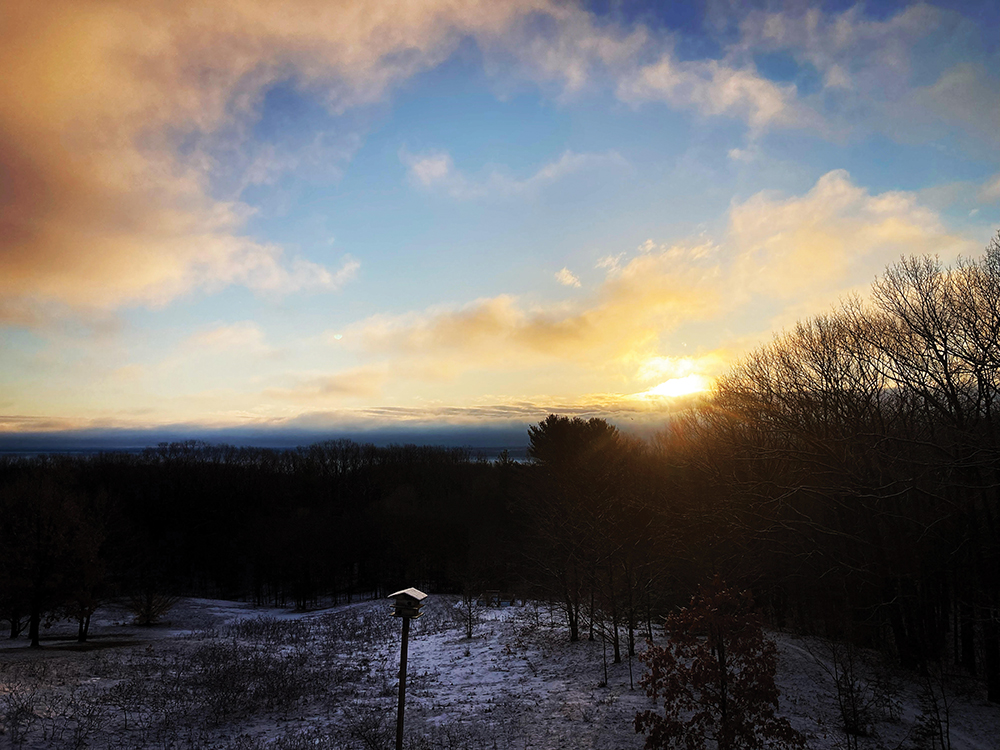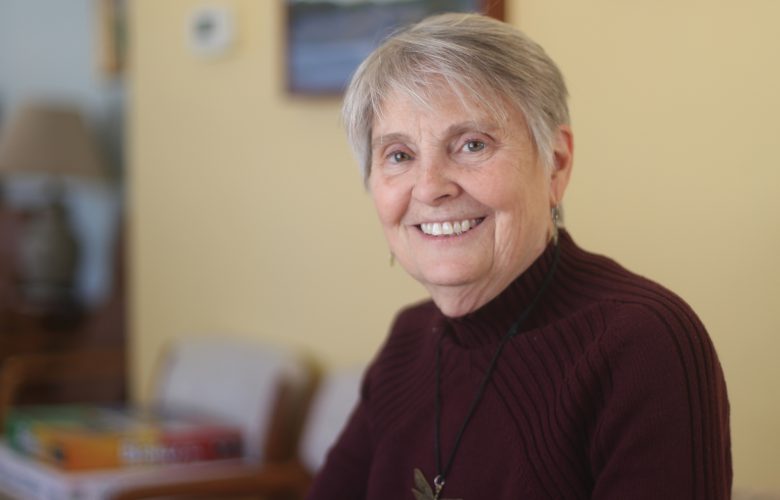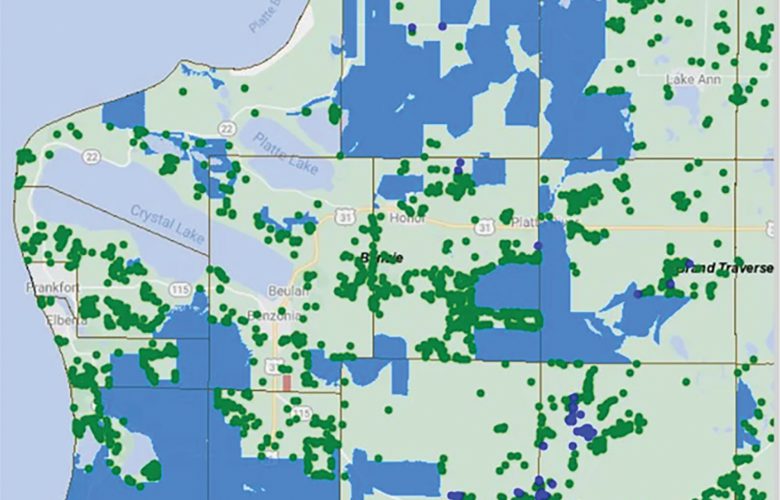To see the forest in the weeds
By Sarah Louisignau
Current Contributor
The land and house I steward are not mine. They were purchased last year by my massage client, and he asked me to house-sit for him while he lives in Texas during the winter. By the time I leave here in May, I will have lived in his home longer than he has.
I have grown very fond of this place, a peninsula on a peninsula in Northwestern Michigan. From big floor-to-ceiling windows that look east, I watch the sunrise over East Grand Traverse Bay every morning. Between the house and the water is a beautiful strip of wild woodlands, home to 80- to 100-year -old trees and many non-human creatures who have become friends.
The homeowner and I recently had a conversation, during which he told me of his plans to level the wild, unmanicured backyard, to put in irrigation, and to get rid of all “that pesky sumac.” During the conversation, I listened and felt strong emotions rise in me; I noticed my preferences about how I would like to see this wild habitat managed. I felt trapped, because it is not my home and I do not really have a say in what happens here.
And yet, I could not sleep afterward.
It felt like one tangible example of how people are trying to make every acre they own more productive, useful, and familiar.
This wild yard is unfamiliar to this man, who lives in the city and just bought this place as an escape. Golf is his preferred outdoor activity. His aesthetic of outside space is the polar opposite to mine. I felt anxiety thinking about how this unkempt but wildly beautiful acreage would be tamed; I felt a deep rebellion rise up inside me, but I tried to hold my tongue—at first.
After two days, the feeling had not left me, had not subsided. I realized that, in order for me to be in alignment with my soul, I needed to speak for the land. On behalf of all wild lands, perhaps. I looked towards the woodline, hoping for a glimpse of a woodland friend for courage. I decided to write to the homeowner:
“I know this isn’t my home, and I have zero say about what happens here, but I have bonded with this land deeply during my time here. I walk it every day. I just have to say: my heart would be sad if the backyard became domesticated.”
I paused, considering how bold I dared to be.
“It’s a wild sanctuary right now. I’ve seen deer, coyote, great horned owl, red-tailed hawk, and many small birds and critters here. They’ve kept me company. They use it—and need it—more than us. Plus, the sumac is medicinal and beautiful all year long but especially in the winter. I love watching the birds play there. Lawns are so boring and terribly high maintenance. This yard is simple, wild, and beautiful as it is. If I had a voice here, this would be it. Thanks for listening.”
Another day passed. I began to worry, Will this be like the last time I spoke up? Will I be asked to leave? Will I have to scramble to find another place to live for the next few months? Old abandonment wounding surfaced, alongside old traumas around moving suddenly and unexpectedly.
Then he replied: “Thank you for the thoughtful message. You are right about lawns being outrageously expensive, for sure. The plan is to grass and irrigate 19,000 square feet behind the house. That is only a half-acre. My lot is six acres, so it will not stretch back quite as long as the neighbor’s yard.”
Wow, I thought, he listened to me. He really took in my opinion, and is considering it. Half an acre isn’t that bad. Maybe this could be a compromise, and maybe I can widdle him down some.
He continued: “The plan is to have a tier/flat area directly behind the house where I can put in a bocce ball court and have a play/hang-out area for guests. I think this will encourage guests to spend more time outside and appreciate the area more.”
Okay, I thought, I can see that—a people-friendly area to ease the city folks into the wild woods beyond the yard. That might not be what he’s thinking, but I secretly have an agenda to encourage appreciation of the wild in him.
“I believe this will provide a balance, and you’ll still have your wild area back in the woods,” he continued. “I would like to clean up those trails a little bit and remove most of the dead timber and maybe even install a small disc golf course starting in the yard and going back into the woods. I think this will enhance the nature of the property and encourage people to go back there.”
Great, disc golf is much less intrusive than regular golf—no grass to water or mow or fertilize! Now we are getting somewhere. And did he just call it “your” wild area in the woods?
He added “I loved waking up and seeing deer almost every morning this summer. I was thinking about getting a feeder and an actual working birdhouse this summer.”
Win! Now we are integrating people with the other animals that live here, I thought, beginning to relax, feeling that dread begin to leave my body.
But then, I was stunned.
“I don’t know about coyotes though,” he continued. “Haven’t seen them, and I don’t want them killing the deer. Close your ears, but I might shoot them if I ever see them.”
Oh heck. Would he actually purchase a gun just to shoot coyotes? Did I just ruin their chances?
I remember the first time I realized there were coyotes in these woods. During the fall, I would notice my dog, Angus, getting very excited along a particular portion of the trails behind the house. I didn’t pay him much mind, until one day, after a good snow this winter, I saw them: paw prints—just a little bigger than Angus’s prints—criss-crossing all over the forest in this one little valley area. It was incredible; they had been hiding. Difficult to count, the way they were weaving about, but I guessed about six to seven animals. They looked like they were playing. For the rest of the winter, I watched their paw-print patterns and never saw any kills or carcasses, so I began to wonder, Is there a den nearby?
Another day, while looking out across the backyard towards the forest edge, I saw two adult deer sauntering along. I stood and watched them; smiling, feeling grateful as I noticed how the sunlight was lighting up the tips of the bare trees above them. A small amount of gold—their bodies and the sunlight—in a forest of white.
And then I saw her. Coyote. Trailing the deer about 300 yards behind, at a nice trot, kicking up little puffs of snow. I remember the mixed emotions I had. But I knew this was the life-death-life cycle in motion. I knew the rightness of it.
“I’ll commit to consulting with you,” the homeowner said, “as I try to improve the space, and maybe we can have a happy medium. I agree, I don’t want it to be unnatural, but I’m a city boy after all.”
Now I had to think fast. I took a few deep breaths. How do I explain succinctly that coyotes are a keynote predator species here? Here goes nothing. I feel like a chess player, plotting my next move.
“Thanks for your thoughtful reply, and thanks for hearing me out. I think a disc golf course would be very fun! As would clearing the paths for people to begin to explore the woods,” I said.
Give him something good, right, yes, and now I pounce!
“About the coyote; they are important members of the ecosystem balance here. We need healthy predators, too, so please don’t shoot them! Without coyotes keeping the deer in check, they would perish on the roadsides and decimate the forest by overgrazing.”
Feeling a bit more empowered, I continued:
“And you were a city boy, but now you’re also a homeowner in a rural area, and that makes you a country boy, too! You don’t want this place to become a city, right? You love this place for its sprawling open lands and beautiful nature.”
And from there, the conversation, still playful, evolved onto other topics. I felt he had heard me, though; he said he was committed to consulting me, and I felt relief.
Maybe the coyotes will continue to live their secret life here after all.
And maybe my voice does matter, and maybe opening my heart to this land that is not ‘mine’—and expressing my love for it—has endeared me to it in more ways than I can imagine.
A while back, I heard a story of a lovely soul walking along the beach, throwing starfish back into the sea. When someone asked him why he bothered—there were millions of starfish—he said, “Because it mattered to that one.”
My plea for the wild land felt like that—although it is not going to save the rainforest from peril, it might save one oak tree in this rural backyard, and that still means something.
Featured Photo Caption: View of East Grand Traverse Bay. Between the house and the water is a beautiful strip of wild woodlands, home to 80- to 100-year-old trees and many non-human creatures—deer, coyote, great horned owl, red-tailed hawk, and many small birds and critters—all living in a life-death-life cycle. Photo by Sarah Louisignau.





What an excellent story. Thank you for sticking up for wildlife.
Beautiful article. I have lived on East Front Street, near NMC, for over 50 years. Last fall, there were 12 deer in my backyard, a coyote, a silver fox and 3 kits. Do not know how they survive on the narrow strip of woodland so close to the 400,000 summer visitors. Just amazed to be blessed by such abundant wildlife within the city limits. Again, thank you for a glorious article. Makes my heart joyful.❤️ Denise C, Sorensen